Single Sign On (SSO) with RemoteApps on Windows Server 2012 (R2)
A RemoteApp is an application, that is running on a Remote Desktop Session Host (RDSH), and only the display output is sent to the client. Because the application is running on a RDSH, you can easily deliver applications to end users. Another benefit is, that data is not leaving the datacenter. Software and data are kept inside the datacenter. RemoteApps can be used and deployed in various ways:
- Users can start RemoteApps through the Remote Desktop Web Access
- Users can start RemoteApps using a special RDP file
- Users can simply start a link on the desktop or from the start menu (RemoteApps and Desktop connections deployed by an MSI or a GPO)
- or they can click on a file that is associated with a RemoteApp
Even in times of VDI (LOL…), RemoteApps can be quite handy. You can deploy virtual desktops without any installed applications. Application can then delivered using RemoteAPps. This can be handy, if you migrate from RDSH/ Citrix published desktops to VMware Horizon View. Or if you are already using RDSH, and you want to try VMware Horizon View.
But three things can really spoil the usage of RemoteApps:
- certificate warnings
- warnings about an untrusted publisher
- asking for credentials (no Single Sign On)
Avoid certificate warnings
As part of the RDS reployment, the assistant kindly asks for certificates. Sure, you can deploy self signed certificates, but that’s not a good idea. You should deploy certificates from your internal certificate authority.
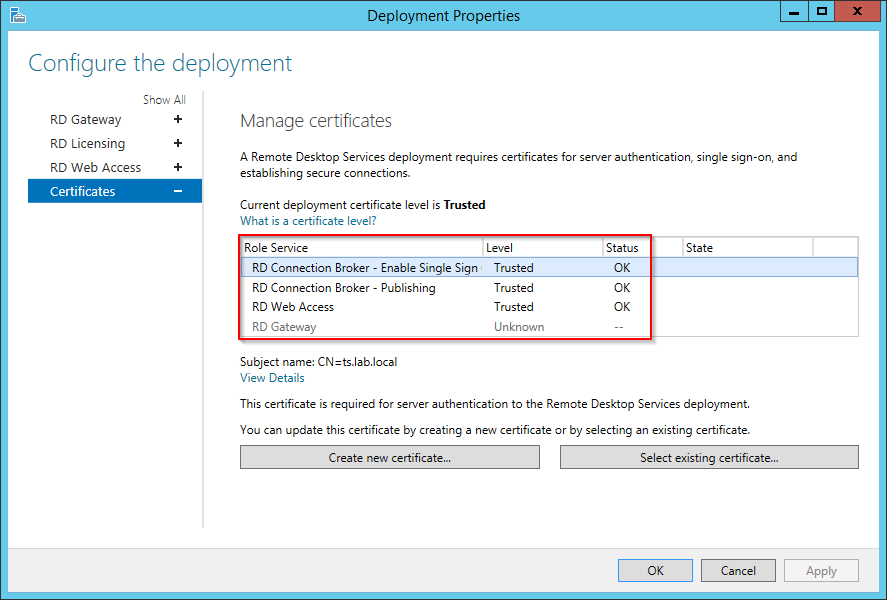
Patrick Terlisten/ vcloudnine.de/ Creative Commons CC0
This is a screenshot from my tiny single server RDS farm. Make sure that you use the correct names for the certificates! If you are using a RDS farm, make sure that you include the DNS name of the RD Connection Broker HA cluster.
If you want to make the RD Web Access publicly available, make sure that you include the public DNS name into the certificate.
Untrusted Publisher
When you try to open a RemoteApp, you might get this message:

Patrick Terlisten/ vcloudnine.de/ Creative Commons CC0
Annoying, isn’t it? But easy to fix. Remember the certificates you deployed during the RDS deployment? You need the certificate thumbprint of the publisher certificate (check the screenshot from the deployment properties > “RD Connection Broker - Publishing”). This is a screenshot from my lab:
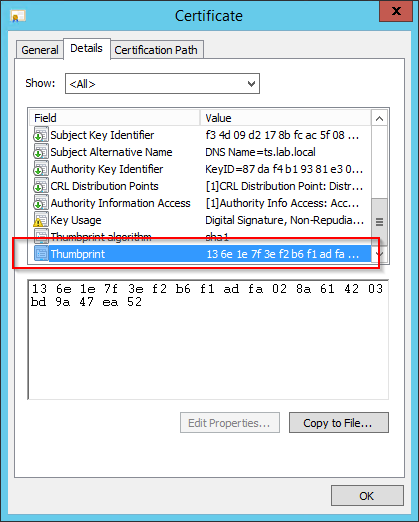
Patrick Terlisten/ vcloudnine.de/ Creative Commons CC0
Take this thumbprint, open a PowerShell windows and convert the thumbprint into a format, that can be used with the GPO we have to build.
("13 6e 1e 7f 3e f2 b6 f1 ad fa 02 8a 61 42 03 bd 9a 47 ea 52").ToUpper().Replace(" ","")
The result is a string without spaces and only with uppercase letters. Now we need to create a GPO. This GPO has to be linked to the OU in which the computers or users reside, that should use the RemoteApp. In my example, I use the user part of a GPO. So this GPO has to be linked to the OU, in which the users reside. The necessary GPO setting can be found here:
User Configuration > Policies >Administrative Templates > Windows Components > Remote Desktop Services > Remote Desktop Connection Client > Specify SHA1 thumbprints of certificates representing trusted .rdp publishers
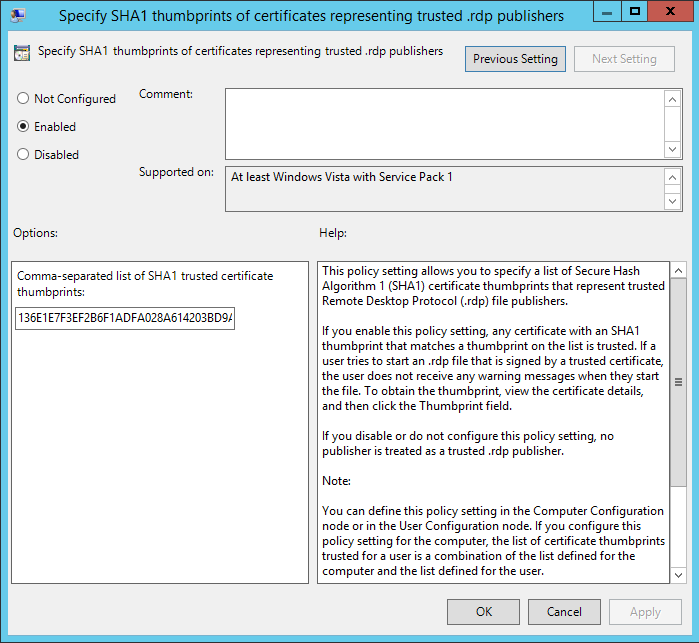
Patrick Terlisten/ vcloudnine.de/ Creative Commons CC0
I use the same GPO to publish the default connection URL. With this setting configured, the users automatically get the published RemoteApps to their start menu. You can find the setting here:
User Configuration > Policies >Administrative Templates > Windows Components > Remote Desktop Services > RemoteAppe and Desktop Connections > Specify default connection URL
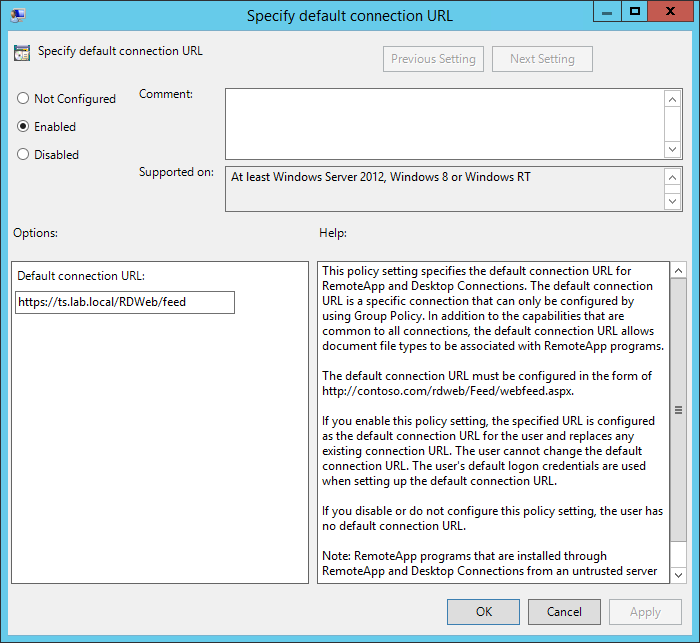
Patrick Terlisten/ vcloudnine.de/ Creative Commons CC0
Credentials dialog
At this point, you will still get a “Asking for credentials” dialog. To allow the client to pass the current user login information to the RDS host, we need to configure an additional setting. Create a new GPO and link this GPO to the OU, in which the computers reside, on which the RemoteApps should be used. The setting can be found here:
Computer Configuration > Policies >Administrative Templates > System > Credentials Delegation > Allow delegating default credentials
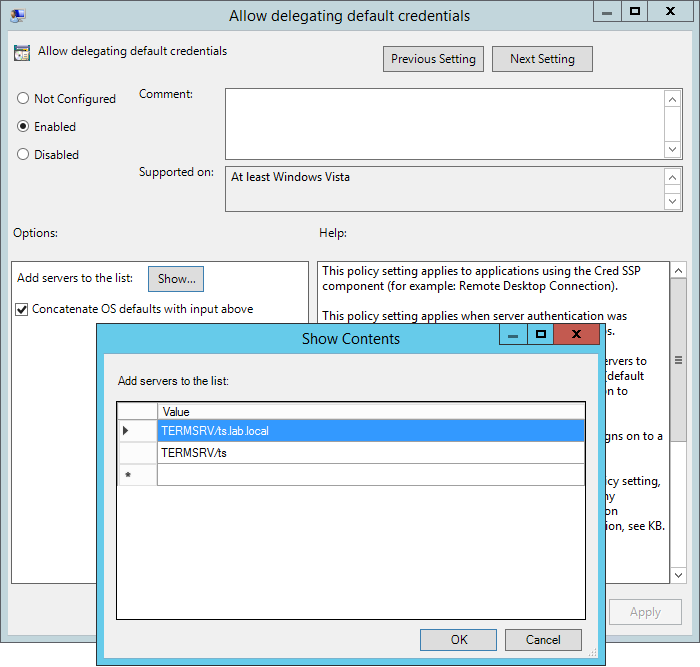
Patrick Terlisten/ vcloudnine.de/ Creative Commons CC0
You have to add the FQDN of your RD Connection Broker server or farm. Please make sure that you add the “TERMSRV” prefix! Because I use a single server deployment, my RD Connection Broker is also my RDS host.
The final test
Make sure that all group policies were applied. Open the Remote Desktop Connection Client and enter the RDS farm name. If everything is configured properly, you should connected without asked for credentials.
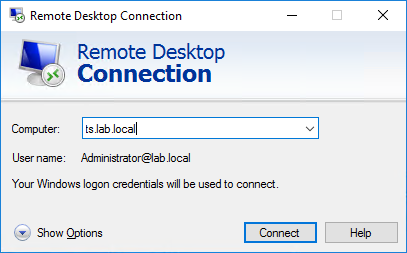
Patrick Terlisten/ vcloudnine.de/ Creative Commons CC0
The same should happen, if you try to start a RemoteApp.
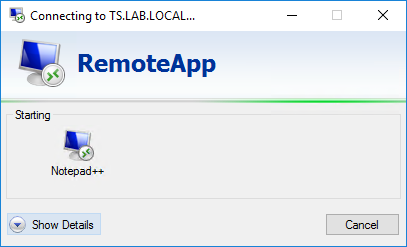
Patrick Terlisten/ vcloudnine.de/ Creative Commons CC0
Troubleshooting
If you are still getting asked for credentials, something is wrong with the credentials delegation. Check the GPO and if it is linked to the correct OU. If you are getting certificate warnings, check the names that you have included in the certificates. Warnings about untrusted publishers may be caused by a wrong SHA1 thumbprint (or wrong format).
